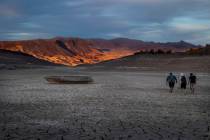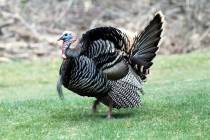Dove hunters might need patience
Dove season opens Tuesday morning, but given what I haven't seen, it could be a slow opener. And what I haven't seen are doves.
While there is a significant dove population that spends much of the year in the Las Vegas Valley, there is generally a noticeable increase in the number of doves during the second half of August. This increase is due to the migration of birds from northern climes, which is triggered by cooling daytime temperatures. My home is situated near a natural corridor that doves use as they head south. The birds tend to stack up in the neighborhood and in nearby open spaces until they feel the urge to move on, but they aren't here yet.
The same is true for areas outside of the valley. Earlier this week I was at Moapa Valley, which still has some pockets of agricultural activity. While there, I spent considerable time on the Overton Wildlife Management Area and noticed hunters doing some preseason scouting. I spoke with a couple of hunters who said they haven't seen the anticipated increase in doves, either.
On the other hand, I did receive encouraging news this week from a gentleman who owns a home in Beaver, Utah. He is an avid bird hunter and told me he has seen doves stacking up in and around town the past couple of weeks. That would put the birds about the same latitude as northern Lincoln County in Nevada, and all it takes to move birds south is a slight change in weather -- so a lot can happen between now and Tuesday.
Something else we haven't seen this summer is rain. That's going to put all available water sources, natural and manmade, at a premium. Water sources might include a natural spring, a leak in a water pipe, an irrigated field, a stock tank or a pond. Doves need water on a daily basis and usually follow the same pattern every day. At dawn, they leave their roosts and fly to a feeding area, where they feed until mid-morning. Then they fly to water before resting during the middle of the day. They repeat this cycle late in the afternoon, then roost for the night, usually within a couple of miles of their water source.
Through the years, I have learned that doves fly close to trees, or perhaps something that might resemble a tree and is taller than surrounding cover. I like to set up in brush near a tree line or near a lone tree for that reason and can generally get in some fairly good pass shooting. If you can find a line of trees or tall brush, look for a gap in the trees or brush where doves might pass from one side to the other. This is usually a good place for an ambush.
Obviously, it's a good idea to check your potential stand for rattlesnakes before you slide into the brush. They will be holed up in the shade during the heat of the day.
Anyone who has hunted doves at least once will attest to the speed at which these birds can fly, but what makes them a tough quarry is their acrobatic flying ability and their knack for making hunters miss. This is especially true once they see you. Years ago, I knew a two brothers who hunted doves in white T-shirts. They were always successful, but I prefer to make myself a little more inconspicuous. A camouflage shirt and hat will aid with concealment, but just about anything in drab colors will help you blend in to your surroundings.
When it comes to shotgun selection for doves, everyone has an opinion. Some prefer a 12-gauge and others a 20. Some older guys like a 16 if they can find the shotshells for it. My feeling is that as long as the gun is legal and you shoot well with it, then use it.
Keep in mind that pump action and autoloading shotguns must be plugged to limit overall shotshell capacity to no more than three. I prefer number 7 shot. If you hunt on a state wildlife management area, or on one of the federal wildlife refuges, nontoxic shot is required.
Freelance writer Doug Nielsen is a conservation educator for the Nevada Department of Wildlife. His "In the Outdoors" column, published Thursday in the Las Vegas Review-Journal, is not affiliated with or endorsed by the NDOW. Any opinions he states in his column are his own. He can be reached at dougnielsen@att.net.

















